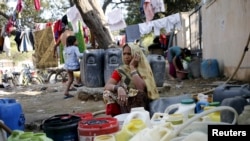Violent protests by a rural Indian caste, during which 16 people were killed, continued for a fourth day in the northern Haryana state, but leaders of the protesting “Jat” community have appealed to rioters to clear blockades after reaching a deal with the government.
The demonstrations highlight the growing resentment among relatively affluent groups as India faces a scarcity of jobs for its massive young population. The protests have paralyzed roads and rail links and caused crippling water shortages in the Indian capital.
The army took control of a key canal, which is the main water source for New Delhi, but authorities said it would take some time to repair the damage done by protesters and restore supply to about 10 million people facing a water scarcity. The shortage prompted authorities to shut schools in the capital.
The protesters are demanding recognition for the land-owning Jat community as a “backward class,” which would make it eligible for quotas set aside for lower castes in civil service jobs and university seats. The government has promised to bring a bill granting their demands in the state assembly next month, but they want written assurances.
The demand for access to quotas by the Jats, a prosperous farming community, has gained momentum as the division of farms has dried up incomes and left younger people struggling for a livelihood.
Children's future in doubt
Ajit Singh Kataria, a leader of the Jat Aarakshan Sangharsh Samiti (Jat Reservation Committee), told VOA most owners possess only tiny plots of land which will not provide sustenance for their children. “We are doing this for the future of our children. We should also get justice…. you should end all quotas and make it a merit-based system,” said Kataria.
The quota system is meant to give opportunities to those excluded for centuries by India’s caste system. In recent years, however, it has fueled resentment among other groups that say they are being shut out of jobs and seats in colleges.
Sanjay Kumar at New Delhi’s Center for Developing Societies says the decline in agriculture in recent years is pushing agrarian communities like the Jats to look for other employment avenues. “They have started realizing that their income from agriculture is far less, even if they put in a lot of effort compared to what people get when you are employed in a government job. So their attraction is because of the pull factor of a government job and push factor from agriculture,” said Kumar.
The Jats are not the only ones fighting for access to quotas in government jobs. Last year, the affluent “Patel” community in Gujarat state raised similar demands.
Jobs, jobs, jobs
Political analysts say the protests highlight the challenge facing Prime Minister Narendra Modi, who won a huge mandate nearly two years ago on a promise to create millions of jobs in a country where half the population is under 25. Despite a growing economy, scaling up jobs on the massive scale that India needs has not proven easy.
Sociologist Dipanakar Gupta says the most sought-after jobs are government or corporate jobs, but employment in the so-called “organized” sector remains “stubbornly” at about 29 million. “So there is a job shortage and at the same time, a large number of rural people, Jats more so, have a degree or diploma and they think they should be able to get a job, but they don’t have the kind of connection that old urban settlers have and they feel deprived on that account.”
Leaders of the “Jat” community say they are satisfied with the promises extended by the government to meet their demands, but that it will take some time to calm the protesters.









